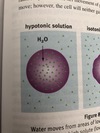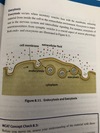Membrane Transport Flashcards
Thermodynaics of Passive tranport
Spontaneous negative delta G
Thermodynamics active tranport
Non spontaneous. Require energy. Positive Delta G
Simple diffusion
Most basic of all membrane traffic processes. Substrate moves down their concentration gradient directly across the membrane. Only for freely permeable particles.
Osmosis
Specific kind of simple diffusion that concerns water.
Water will move from a region of lower solute concentration to one of a higher solute concentration.
Moves from a more dilute solution down the gradient to a region that is more concentrated
Water trys to bring equimolarity
Hypotonic solution
The concentration of solutes inside the cell is higher than the surrounding solution.
Cell will swell as water rushes in

Hypertonic solution
Solution that is more concentrated than the cell itself.
Water will move out of the cell causing it to shrink

Isotonic solution
The solutions inside and outside the cel are equimolar.
This doesn’t stop movement, it just means there is equal movement on both sides

Colligative property
A physical property of solutions that is dependent on the concentration of dissolved particles not on the chemical idenity of those particles
Osmotic pressure, vapor pressure, boiling point, freezing point, etc
Osmotic pressure
Water will diffuse from where there is a low concentration to where there is a high concentration to equal it out.

Facilitated diffusion
Simple diffusion for molecules that are impermeable to the membrane (large, polar or charged)
Requires integral membrane proteins to serve as transporters or channels for these substrates
Active transport
Results in the net movement of a solute against its concentration gradient, just like a ball rolling UP hill.
Always requires energy, but source can vary.
Primary active transport
Uses ATP or another energy molecule to directly power the transport of molecules across a membrane.
think an ATPase
Secondary active transport
Known as coupled transport
Doesn’t use ATP hydrolysis but uses the energy released from a normal particle going down it’s gradient to allow a different particle to go up against the gradient.
symport and antiport
Symport
Type of secondary active transport where both particles flow in the same direction across the membrane
Antiport
type of secondary active transport when particles flow in opposite directions across the membrane



